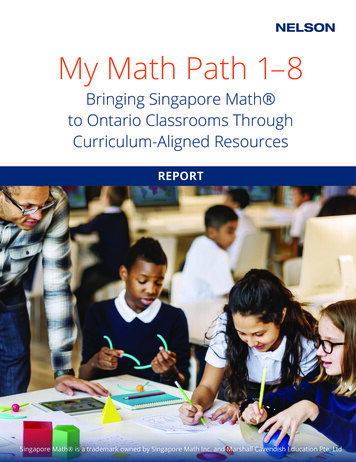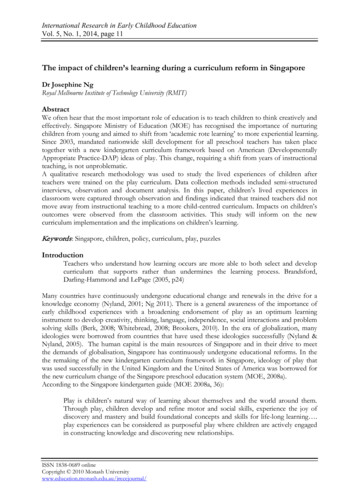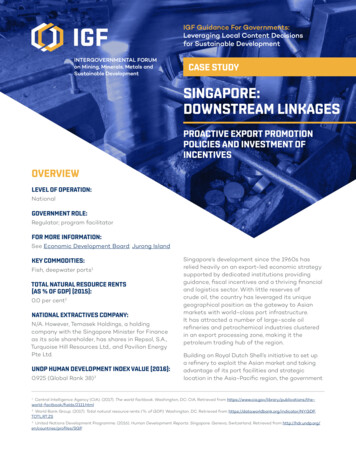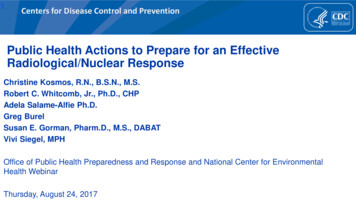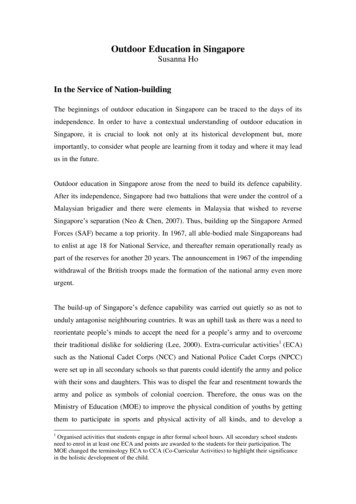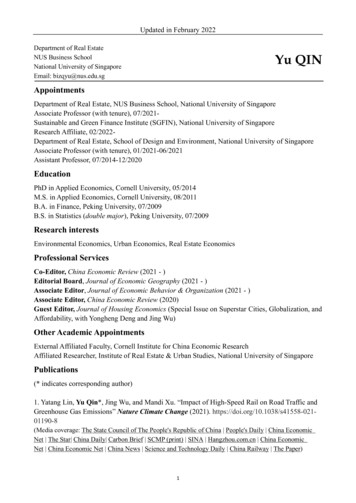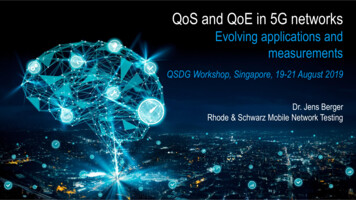
Transcription
QoS and QoE in 5G networksEvolving applications andmeasurementsQSDG Workshop, Singapore, 19-21 August 2019Dr. Jens BergerRhode & Schwarz Mobile Network Testing
Agendaı What is 5G improving technicallyı 5G deployment – first step is doneı ‘Who’ is using 5G and ‘how’ the 5G network will be used?ı New applications and use cases arising?ı How to measure QoS and QoE under 5G?ı How to score network performance?
5G technical improvementsSimply spoken: What do people expect and what are 5G promises?ı More data-speed! Technically it means more transport capacity.ı More interactivity! Technically it means very short transport latency.ı More flexibility! Technically addressed by ‘network slices’ serving different needs and QoS requirements.ı New applications and use cases! (Finally)
5G deployment – First step is done in fieldı First 5G real field deployments are done!ı What does it mean in a first step? 5G EN-DC 5G non-standalone access, covered by eMMB Device is connected by LTE (4G), one or more 5G carriers are added for supporting downlink capacity Requires dual coverage (4G 5G) Does only improve downlink, no uplink improvementsı What is next? 5G standalone access (no dual coverage required, uplink improved too) URLLC, mMTC
Who uses 5G and how?ı Todays networks are optimized for humans using smartphonesı In 5G new classes of users will take advantage of the infrastructure Humans (smartphone use case) Automotive (connected, autonomous driving, Vehicle-to-X) Industry 4.0 (Smart Manufacturing, private 5G networks) IoT, mMTC (Smart City, Connected Energy,.)Each class causes individual traffic patterns and has individual requirements to the network!A network optimized for human users may not deliver best performance for cars or industry.
What to expect from 5G?ı Human users will be one user class amongst othersı Main popular applications will remain but evolveı New application areas and use cases will belaunched and usedı It is not a ‘switch-on’ rather a ‘phase-in’ Applications will use what is made available There will be a transition phaseSource:6
Short break! about Terminology.ı There is use of terms as ‘service’, ‘application’, ‘use case’ and more.ı Services are usually used for technical, primary services, e.g. telephony service, mobile data service There is also a term ‘messaging service’ applied to OTT messengers. There will be for sure no ‘AR/VR service’ ı Let’s agree for now:(it is not fully correct and not applicable for all cases)(there are ‘grey zones’ between)Use Casee.g. VR GamingApplicatione.g. Virtual RealityService (up to Transport)e.g. UDP
Short break! about Terminology.ı There is use of terms as ‘service’, ‘application’, ‘use case’ and more.(it is not fully correct and not applicable for all cases)(there are ‘grey zones’ between) break is over: 5G!VRUHDDASHService (up to Transport)Drone Controlı Let’s agree for now:Real EstateViewingThere will be for sure no ‘AR service’ RemoteInspection RetailShoppingHomePre-viewThere is also a term ‘messaging service’ applied to OTT messengers.VR Gaming WhatsApp VideoConferencingı Services are usually used for technical primary services, e.g. telephony service, mobile data service
Let’s start simple: How telephony will evolve in 5G?ı 3GPP Telephony (telephony as primary service) QoE makes no significant difference to 4G VoLTE Very short call setup time, EVS 24.4 high quality coding Accessibility and sustainability will further increase Video Telephony may increase but strong competition by OTTı OTT Telephony Today (4G) OTT telephony applications are still behind VoLTE Lower accessibility and sustainability (more failed and dropped calls) Voice quality is lower due to time-warping and packet loss (unreliable channels), not by codingSignificant improvement in 5G (more reliable channels, short latency)OTT services will become fully equivalent or even superior to VoLTE (because of wider functionality)
Data applications in in 5G, the vast majorityı Existing applications and use cases Today’s use cases will remain popular(HTTP-Browsing, Video streaming, OTT Messaging, )ı Evolving applications and use cases (based on existing use cases) 4K/8K video, HDR Similar to today’s video streaming, ‘just’ more bandwidth 360 video, Virtual Reality Similar to today’s video streaming, ‘just’ more bandwidth Rendering will move from device to core (in interaction with device) Live broadcasting, video upstream Similar to today’s approach, more bandwidth, more reliable Real time gaming Similar to today’s approach, more bandwidth, shorter latency, more reliable Rendering will move from device to core (in interaction with device)ı New applications and use cases Augmented reality and AR gaming, remote control, VR retail shopping, Highly adaptive to network conditions by ML and AI techniques
Data services: Use cases and applicationsı There will NOT be totally independent implementationsof applications (e.g. AR, live broadcasting, )Applicationfor individual services and use casesı Individual use cases will usesame underlying libraries and techniques andmay lead to similar data patterns in the networkı Differences will be in the objectives and therequirements in performanceı Example AR/VR used in many different areasThere will benot the AR use case andnot the AR QoE modelSource:AreaExample Use Cases
Data services: Use cases and applicationsThere will benot the AR use case andnot the AR QoE modelVRReal EstateViewingRemoteInspectionExample Use CasesUHDDASHService (up to Transport)Source:Drone Controlı Example AR/VR used in many different areasRetailShoppingHomePre-viewı Differences will be in the objectives and therequirements in performanceVR Gamingı Individual use cases will usesame underlying libraries and techniques andmay lead to similar data patterns in the networkAreaWhatsApp VideoConferencingı There will NOT be totally independent implementationsof applications (e.g. AR, live broadcasting, )Applicationfor individual services and use cases
How to measure QoS and QoE in 5G?ı KPIs and QoS parameters are independent from radio and access technology,but the acceptance thresholds have to be adjusted to new services.ı QoE is not directly depending of radio technology, but the expectation will increase with higherperformance. Increasing expectation changes QoE but it happens for all technologies then.QoE modelKPIs / QoSTechnical Layer (RF, IP, Application)QoE is based on Experience,experience on ExpectationExpectation will change with newand evolving applications over timeObjectives and thresholds basedon technical needs forapplicationsApplications will become much moreadaptive to network conditions thantoday by ML and AI techniques!
How to measure QoS and QoE in 5G?ı QoE considers a user’s expectation, QoS is more rational based on technical measurementsı Existing applications and uses cases (e.g. Web-Browsing, Video Streaming) are used in 5G too KPIs and QoS parameters are the same as for 4G and below, they are widely independent from radio technology Quality usually reads as ‘quality of media presentation’, e.g. Speech-MOS or Video-MOS QoE models stay for a while too. Along with increasing expectation, QoE models have to be re-adjustedı Evolving and new services (e.g. 4K Video, Virtual Reality, Real-time Broadcasting, Real-time Gaming) Many existing KPIs and QoS parameters and concepts can be used (access time, failure ratio, ), New KPIs and QoS parameters are required for e.g. response times, seamless connectivity and similar New QoE parameters for quality (e.g. 4K Video, 360 Video) are required Quality will go beyond today’s ‘media presentation’ concept and will include e.g. ‘interactivity’
What drives subscriber’s QoE and satisfaction in general?The R&S QoE concept considers three different dimensionsand can be adjusted to almost each application and/or use caseı Accessibility and sustainability Do I have access to the ‘service’ at all and is it ‘technically’ kept? (Do I stop waiting because of too long waiting times?) (Do I stop because of bad quality or limited functionality?)ı Waiting time for ‘action’ (task being started and/or completed) How long the access takes (e.g. Call Setup Time, Video Access Time)ı How is the quality / experience during active use How is ‘quality’ (e.g. video quality) How is interaction, ‘fluentness’, response time, QoEof a use caseor application
What drives subscriber’s QoE and satisfaction in general?The R&S QoE concept considers three different dimensionsand can be adjusted to almost each application and/or use caseı Accessibility and sustainabilityCounted as‘soft drop’? Do I have access to the ‘service’ at all and is it ‘technically’ kept? (Do I stop waiting because of too long waiting times?) (Do I stop becauseof badfunctionality?)I stop,if quality or limitedI stop,ifwaiting isquality isı Waiting time fortoo‘action’startedlong.(task beingtoolow.and/or completed) How long the access takes (e.g. Call Setup Time, Video Access Time)ı How is the quality / experience during active use How is ‘quality’ (e.g. video quality) How is interaction, ‘fluentness’, response time, QoEof a use caseor application
How to measure QoS and QoE of 5G applications und use cases?ı The number of applications and related use cases will increase by sizes in 5Gı There are always ‘common’ QoS/QoE indicators as Availability, accessibility and sustainability of the requested use case or application Waiting time to use the offered functionality Availability will increase to ‘always available’, Waiting time will become shorter and shorter Focus will move towards ‘quality’, means experience of the active use caseı The quality and experience of the use case’s functionalityas such is determined by three dimensions of transport: Transport capacity (‘bitrate’) Transport duration (’latency’) Transport continuity (‘seamless’ transport’)
How to measure QoS and QoE of 5G applications and use cases?ı The number of applications and related use cases will increase by sizes in 5Gı There are always ‘common’ QoS/QoE indicators as Availability, accessibility and sustainability of the requested use case or application Waiting time to use the offered functionality Availability will increase to ‘always available’, Waiting time will become shorter and shorter Focus will move towards ‘quality’, means experience of the active use caseı The quality and experience of the use case’s functionalityas such is determined by three dimensions of transport: Transport capacity (‘bitrate’) Transport duration (’latency’) Transport continuity (‘seamless’ transport’)Individual applicationsand use cases haveindividual requirements
Application Augmented Reality as exampleı There are tons of use cases using Augmented Realityı QoE depends on the use case, there is no general AR QoE modelı But: The underlying KPIs and technical parameters are the same,differences are how they are weighted in a QoE modelQoE ARTelephonyQoE ARQoE ARPersonal Trainer Assisted SurgeryKPIs / QoSTechnical Layer (RF, IP, application)
Summaryı Most of today’s popular applications and use cases will continue under 5G, KPIs and QoS will further apply ‘Service’ accessibility and sustainability will increase to ‘always available’ ‘Waiting’ time will be very short Focus will move more and more to quality in a given, running (active) use case Existing QoE models have to be re-adjusted (mid-term)ı Evolving and new applications and use cases will require new QoE modelsı Increased bitrate and related KPIs are not sufficient anymore Interactivity and continuity of transport become crucial for real-time applications under 5G KPIs and QoS parameters for interactivity and continuity have to be developed and accepted New applications will be highly adaptive to network conditions by ML / AI and optimize QoE over time
How to score a general network’s performance? ready for 5G?ı Performance scoring considers different typical applications and use casesı Performance is based on QoE (today for human users)ı Regional or other morphological categories can be applied and weightedı ETSI TR 103 559 (brand new: ratified 07/2019)‘Best practices for robust network QoS benchmark testing and scoring’ı ITU E.840 (06/2018)‘Statistical framework for end-to-end network-performancebenchmark scoring and ranking’
How to score a general network’s performance?Principle: An aggregation modelQoE of applications‘Availability’‘Access Time’‘Quality’WeightAggregationThis score describesthe performance in acertain location, time,situation for furthercomparison with otherregions etc.
How to score a general network’s performancePrinciple: An aggregation modelCity930POORTownGOODThis score describes theperformance ‘countrywide ORGOOD for further comparisonwith competitors or othermarkets etc.
Network performance scoring under 5G requirementsı Many of today’s applications remain or will ‘only’ evolveı New applications will become more real-time and more interactiveı The principle of an aggregation model can be keptı The change will be on lower layers Today: Performance based on simple up-/download functionalities (browsing, video streaming, posting) 5G:Real-time functionality and interactivity (no established measures in scoring methods)Consideration of typical applications and use cases based on AR/VR, remote control, Today: Scoring models ‘performance as by humans’ 5G:Multiple models scoring ‘performance as by Automotive’, ‘ as by Remote Factoring’,
Network performance scoring under 5G requirementsı Many of today’s applications remain or will ‘only’ evolveı New applications will become more real-time and more interactiveı You may remember:This is key for real-time interaction
Thank you! and keep being real and interactive
How to measure QoS and QoE in 5G? ıQoE considers a user's expectation, QoS is more rational based on technical measurements ıExisting applications and uses cases (e.g. Web-Browsing, Video Streaming) are used in 5G too KPIs and QoS parameters are the same as for 4G and below, they are widely independent from radio technology



